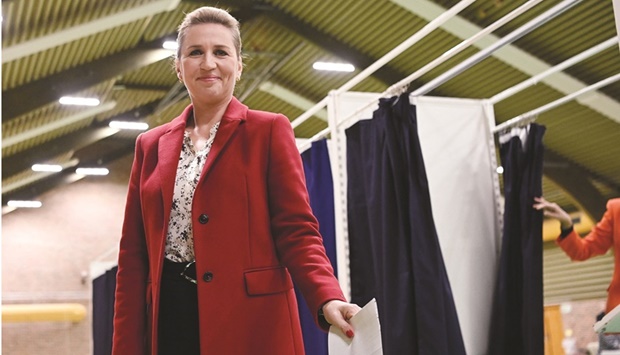Denmark’s left-wing bloc led by Prime Minister Mette Frederiksen appeared to take the lead in yesterday’s general election but without a majority, exit polls showed, setting the new centrist Moderate party up as likely kingmaker.
Exit polls published by broadcasters DR and TV2 gave the left-wing “red” bloc between 85 and 86 of the 179 seats in parliament.
Meanwhile the “blues” — an informal liberal and conservative alliance supported by three populist parties — were forecast to take between 72 and 73 seats.
With neither side gaining their own majority, both sides will need the backing of the Moderates Party — a party founded earlier this year by two-time prime minister Lars Lokke Rasmussen and which was credited with 17 seats — to form a government.
The election was triggered by the “mink crisis” that has embroiled Denmark since the government decided in November 2020 to cull the country’s roughly 1mn minks over fears of a mutated strain of the novel coronavirus.
The decision turned out to be illegal, however, and a party propping up Frederiksen’s minority Social Democrats government threatened to topple it unless she called elections to regain the confidence of voters.
The election campaign was dominated by climate concerns, inflation and healthcare.
“Climate issues and psychiatry (mental health issues), but mostly climate, are the reasons behind my vote,” 46-year-old Lone Kiitgaard told AFP after casting her ballot in central Copenhagen on Tuesday, without disclosing who she voted for.
“This election could be really close and there is a risk that there will be a blue government after today,” Frederiksen admitted after she voted at a badminton centre-turned-polling station northwest of Copenhagen.
Nikolaj Sommer, editor of Danish business daily Borsen, told AFP he made his choice after studying the parties’ economic programmes.
“That we are not actually stimulating inflation in Denmark, I think that’s a very important thing for me. And of course the Danish welfare system and how we’re going to run it in the long run,” the 47-year-old journalist said.
Both the left and the right have made repeated appeals to Lokke Rasmussen, who campaigned on reforming the healthcare system.
Frederiksen has floated the idea of a coalition government, led by herself, and has said she is willing to discuss healthcare reforms.
Liberal Party leader Jakob Ellemann-Jensen, her main challenger on the right, has called for Lokke Rasmussen to align with his former party colleagues.
“We will... do our outmost to be the bridge, that’s the whole idea behind this,” Lokke Rasmussen told AFP after casting his ballot in central Copenhagen.
Only two months ago, the party polled at around two percent but soared to between 9.3-10% support in final opinion polls.
Lokke Rasmussen, who said “it’s better to be a joker than a joke”, does not envision becoming prime minister a third time, despite being a potential kingmaker.
“That’s not in my mind,” he said.
Protective of the prosperity and social cohesion of the Nordic welfare state, Denmark championed ever-stricter migration policies for over 20 years.
Advocating a “zero refugee” policy, the Social Democrats government is working on setting up a centre to house asylum seekers in Rwanda while their applications are processed.
As most parties back the restrictive policies, the issue is rarely up for debate.
Climate, on the other hand, is of great concern to Danes.
On Sunday, some 50,000 people, including the prime minister, gathered for the “People’s Climate March” in Copenhagen.
But while there is widespread agreement on some issues, Denmark’s political landscape is splintered with a total of 14 parties vying for the 179 seats in parliament.
Four seats are reserved for the overseas autonomous territories: Greenland and the Faroe Islands.
Voter turnout is traditionally high in Denmark. In the 2019 election, 84.6% of some 4.2mn eligible voters cast a ballot.

Danish Prime Minister and Chairwoman of The Social Democratic Party Mette Frederiksen casts her vote at the polling station in Hareskovhallen near Vaerlose, north of Copenhagen. (AFP)


